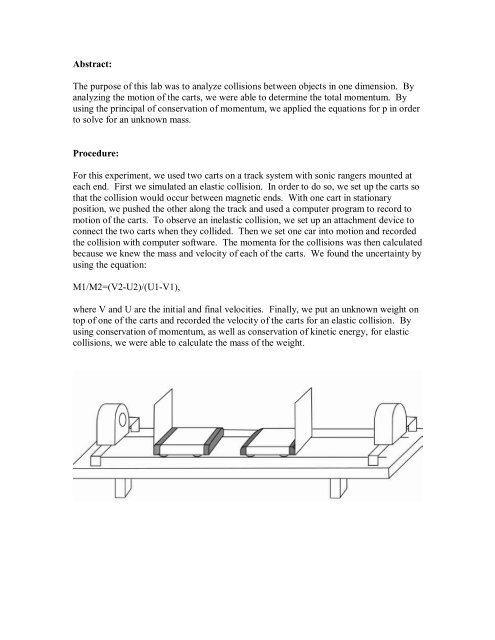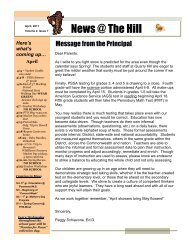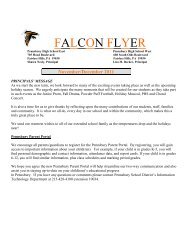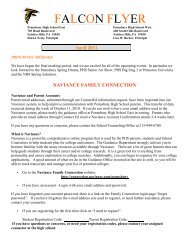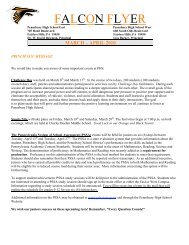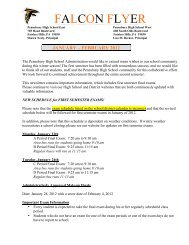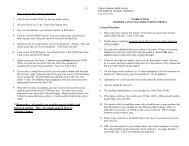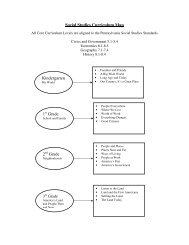Abstract: The purpose of this lab was to analyze collisions between ...
Abstract: The purpose of this lab was to analyze collisions between ...
Abstract: The purpose of this lab was to analyze collisions between ...
Create successful ePaper yourself
Turn your PDF publications into a flip-book with our unique Google optimized e-Paper software.
<strong>Abstract</strong>:<br />
<strong>The</strong> <strong>purpose</strong> <strong>of</strong> <strong>this</strong> <strong>lab</strong> <strong>was</strong> <strong>to</strong> <strong>analyze</strong> <strong>collisions</strong> <strong>between</strong> objects in one dimension. By<br />
analyzing the motion <strong>of</strong> the carts, we were able <strong>to</strong> determine the <strong>to</strong>tal momentum. By<br />
using the principal <strong>of</strong> conservation <strong>of</strong> momentum, we applied the equations for p in order<br />
<strong>to</strong> solve for an unknown mass.<br />
Procedure:<br />
For <strong>this</strong> experiment, we used two carts on a track system with sonic rangers mounted at<br />
each end. First we simulated an elastic collision. In order <strong>to</strong> do so, we set up the carts so<br />
that the collision would occur <strong>between</strong> magnetic ends. With one cart in stationary<br />
position, we pushed the other along the track and used a computer program <strong>to</strong> record <strong>to</strong><br />
motion <strong>of</strong> the carts. To observe an inelastic collision, we set up an attachment device <strong>to</strong><br />
connect the two carts when they collided. <strong>The</strong>n we set one car in<strong>to</strong> motion and recorded<br />
the collision with computer s<strong>of</strong>tware. <strong>The</strong> momenta for the <strong>collisions</strong> <strong>was</strong> then calculated<br />
because we knew the mass and velocity <strong>of</strong> each <strong>of</strong> the carts. We found the uncertainty by<br />
using the equation:<br />
M1/M2=(V2-U2)/(U1-V1),<br />
where V and U are the initial and final velocities. Finally, we put an unknown weight on<br />
<strong>to</strong>p <strong>of</strong> one <strong>of</strong> the carts and recorded the velocity <strong>of</strong> the carts for an elastic collision. By<br />
using conservation <strong>of</strong> momentum, as well as conservation <strong>of</strong> kinetic energy, for elastic<br />
<strong>collisions</strong>, we were able <strong>to</strong> calculate the mass <strong>of</strong> the weight.
Data:<br />
m(cart)=.556g unless otherwise specified.<br />
Data for elastic Collisions<br />
Test # Vi1(m/s) Vf1(m/s) Vi2(m/s) Vf2(m/s) V2- Total<br />
U2/U1-V1 Momentum<br />
Before the<br />
collision<br />
Error Total<br />
Momentum<br />
After the<br />
collision<br />
Error<br />
1 0.245 0 0 0.243 0.991837 0.13622 0.001172 0.135108 0.001162<br />
2 0.259 0 0 0.247 0.953668 0.144004 0.001239 0.137332 0.001181<br />
3 0.193 0 0 0.184 0.953368 0.107308 0.000923 0.102304 0.00088<br />
4 0.288 0 0 0.278 0.965278 0.160128 0.001377 0.154568 0.00133<br />
5 0.21 0 0 0.202 0.961905 0.11676 0.001004 0.112312 0.000966<br />
Data for inelastic ones<br />
Test # Vi1(m/s) Vf1(m/s) Vi2(m/s) Vf2(m/s) V2- Total<br />
U2/U1-V1 Momentum<br />
Before the<br />
collision<br />
Error Total<br />
Momentum<br />
After the<br />
collision<br />
Error<br />
1 0.238 0.119 0 0.115 0.966387 0.132328 0.017511 0.130104 0.004036<br />
2 0.188 0.086 0 0.085 0.833333 0.104528 0.003243 0.095076 0.002949<br />
3 0.225 0.107 0 0.113 0.957627 0.1251 0.003881 0.12232 0.003795<br />
4 0.355 0.176 0 0.174 0.972067 0.19738 0.006123 0.1946 0.006037<br />
5 0.287 0.14 0 0.14 0.952381 0.159572 0.00495 0.15568 0.004829<br />
Data for Unknown<br />
For <strong>this</strong> section, m1=.556 g+unknown; m2=.556 g<br />
Test # Vi1 Vf1 Vi2 Vf2 Mass <strong>of</strong><br />
unknown<br />
1 0.217 0.047 0 0.272 0.3336<br />
2 0.214 0.042 0 0.267 0.307093<br />
3 0.236 0.047 0 0.29 0.297122<br />
Average Unknown Mass = .32 g ± .02<br />
Force data
Test<br />
#<br />
Analysis:<br />
Vi1 Vf1 Vi2 Vf2 Mass <strong>of</strong><br />
unknown<br />
Acceleration<br />
for cart 1<br />
Acceleration<br />
for cart 2<br />
Force <strong>of</strong><br />
2 on 1<br />
Force <strong>of</strong><br />
1 on 2<br />
1 0.181 0.053 0.237 0.473469 -0.67 0.939 0.689744 0.522084<br />
<strong>The</strong>re calculations were all performed on Excel by entering the formulas for the columns<br />
(V2-U2)/(U1-V1) and momentum (m1v1+m2v2). m <strong>was</strong> imputed as the mass <strong>of</strong> the cart as<br />
the cart had no weights on it (.556 g) and v <strong>was</strong> velocity <strong>of</strong> the cart. Error <strong>was</strong> calculated<br />
in a two step process. First, we halved the range <strong>of</strong> the (V2-U2)/(U1-V1) values and<br />
divided it by the square root <strong>of</strong> the number <strong>of</strong> data values for each set. This % error value<br />
<strong>was</strong> then multiplied by the momentum valued <strong>to</strong> obtain error. <strong>The</strong> mass <strong>of</strong> the unknown<br />
<strong>was</strong> calculated using<br />
m v m v m v m v<br />
m<br />
1 1o 2 2o 1 1 f 2 2 f<br />
1<br />
1<br />
m ( v v )<br />
2 2 f 2o<br />
v v<br />
1o 1f<br />
m m m<br />
cart unknown<br />
m ( v v )<br />
m m<br />
2 2 f 2o<br />
unknown<br />
v1o v1f<br />
cart<br />
Summary and Answers:<br />
Although our data seems <strong>to</strong> show that momentum isn’t perfectly conserved, it is<br />
theoretically conserved in both elastic and inelastic <strong>collisions</strong> for a closed system. <strong>The</strong><br />
data reflects what we would expect once you take in<strong>to</strong> account the forces that act on the<br />
non-closed track system. One reason our data does not show perfect conservation <strong>of</strong><br />
momentum is because there is friction in the tracks which causes the carts <strong>to</strong> slow down.<br />
For the elastic collision case, the difference <strong>between</strong> the velocities before and after should<br />
be the same. This is because <strong>of</strong> the following:<br />
Note: u denoted before, v denotes after, subscripts denote different masses<br />
From conversation <strong>of</strong> kinetic energy:<br />
1 2<br />
m1u1 2<br />
1 2<br />
m2u2 2<br />
1 2<br />
m1v1 2<br />
1 2<br />
m2v2 2<br />
2<br />
m u<br />
2<br />
m u<br />
2<br />
m v<br />
2<br />
m v<br />
1 1 2 2 1 1 2 2<br />
m ( u v ) m ( v u )<br />
2 2 2 2<br />
1 1 1 2 2 2<br />
m ( u v )( u v ) m ( v u )( v u<br />
)<br />
1 1 1 1 1 2 2 2 2 2
From conversation <strong>of</strong> momentum:<br />
m u m u m v m v<br />
1 1 2 2 1 1 2 2<br />
m u m v m v m u<br />
1 1 1 1 2 2 2 2<br />
m ( u v ) m ( v u )<br />
1 1 1 2 2 2<br />
Dividing both sets <strong>of</strong> equations:<br />
m1( u1 v1)( u1 v1) m2( v2 u2)( v2 u2)<br />
m ( u v ) m ( v u )<br />
1 1 1 2 2 2<br />
u v v u<br />
1 1 2 2<br />
u u v v<br />
1 2 2 1<br />
Our data shows minor discrepancies (compared v10 <strong>to</strong> v2f since other values are 0). This<br />
is once again because <strong>of</strong> friction in the track.<br />
While our experiment shows one way <strong>to</strong> find mass without weighing the object, there are<br />
countless other methods that can be utilized. You could find the period <strong>of</strong> the mass <strong>of</strong> a<br />
spring by using . You could also find it’s mass vis-à-vis another mass using<br />
gravitational pull ( ). Also calculations can be done with conversation <strong>of</strong><br />
energy <strong>to</strong> determine mass. Finally, Millikan and Thompson determined the mass <strong>of</strong> an<br />
electron by using the charge <strong>to</strong> mass ratio and then finding the charge <strong>of</strong> that electron.<br />
Similar methods can be used <strong>to</strong> find mass if one object is charged and then projected<br />
through an electric field. <strong>The</strong> deflection due <strong>to</strong> the field can be used <strong>to</strong> determine mass.<br />
Conclusion:<br />
In <strong>this</strong> <strong>lab</strong>, we explored the law <strong>of</strong> the conversation <strong>of</strong> linear momentum. Using that law,<br />
we determined the mass <strong>of</strong> an unknown block <strong>to</strong> be .32 g ± .02.


